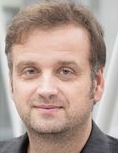Co-Located Conference AgendasLab-on-a-Chip & Microfluidics Europe 2019 | Organ-on-a-Chip & Tissue-on-a-Chip Europe 2019 | Point-of-Care, Biosensors & Mobile Diagnostics Europe 2019 | 

Tuesday, 18 June 201907:45 | Conference Registration, Materials Pick-Up, Morning Coffee and Tea in the Exhibit Hall | 08:45 |  | Conference Chair Chairperson's Welcome and Introduction to the Conference
Nancy Allbritton, Kenan Professor of Chemistry and Biomedical Engineering and Chair of the Joint Department of Biomedical Engineering, University of North Carolina and North Carolina State University, United States of America
|
| |
Session Title: Opening Plenary Session |
| | 09:00 |  | Keynote Presentation Optofluidic Labs-on-Chip For Single Molecule Analysis
Holger Schmidt, Narinder Kapany Professor of Electrical Engineering, University of California-Santa Cruz, United States of America
Lab-on-chip devices have long held the promise of providing a convenient and rapid way to analyze small amounts of biological samples. However, when pushed to the ultimate limit of single molecule sensitivity, the detection mechanism is often based on off-chip elements. I will discuss a chip-scale platform that offers both integrated optical and electrical single molecule analysis. Optical integration is achieved by using liquid-core waveguides interfaced with traditional photonic elements to implement advanced functionalities. Examples include multiplex detection of single viruses, simultaneous detection of proteins and nucleic acid biomarkers, and front-to-back sample handling and single DNA detection on a single chip. Electrical single molecule analysis is achieved by integration of solid-state nanopores. Novel nanopore detection capabilities such as feedback-controlled delivery of single molecules to a fluidic channel are demonstrated. The combination of both optical and electrical detection modalities results in a novel, high throughput platform for single molecule analysis. |
| 09:30 |  | Keynote Presentation Organs-on-Chips: Analytical Tools and Objects for Analysis
Elisabeth Verpoorte, Chair of Analytical Chemistry and Pharmaceutical Analysis, University of Groningen, Netherlands
Organs-on-chips (OoC) can be viewed as biological processing units, meant to replicate on a smaller scale the cell architecture and functioning of the organs they represent. OoC may be used to probe and thus better understand the mechanisms by which organs function. Mostly, though, they will be used as in vitro processing tools, to yield insight as to the fate of compounds like drugs or foodstuffs in vivo. Either way, merging analytical detection technologies with microfluidics and cell culture is key to the development of these systems for advanced in vitro analysis. Several examples of analytical approaches for monitoring liver slice behavior stemming from our labs will be presented in this presentation. |
| 10:00 |  | Keynote Presentation New Opportunities in Acoustofluidic Processing of Liquid Biopsies
Thomas Laurell, Professor, Department of Biomedical Engineering, Lund University, Sweden
Blood sampling and molecular analysis of plasma is the most common clinical diagnostic modality in modern health care. With more advanced means to downstream processing, sub components of blood can be isolated, improving the diagnostic outcome. Detection and analysis of rare events is specifically an area where high performance isolation of sub components of blood is critical and where lab-on-a-chip technology has paved the way for several new approaches. Acoustic forces in combination with microfluidics has open new avenues for high performance blood cell separation, enabling isolation of cancer cells from blood, leukocyte sub populations and more recently also enrichment and purification of extracellular vesicles. Our initial efforts in isolating circulating tumor cells using acoustophoresis in clinical scale prostate cancer patients samples will be reported.
Although conventional acoustophoresis is limited in is ability to manipulate particles smaller than 1 um secondary acoustic effects can alleviate this short coming. Scattered ultrasound between larger particles, that can be retained in a local acoustic field in a microchannel, can be utilized to enrich submicron vesicles on the larger “trapping particles”. Based on this we have developed a microfluidic platform that enables isolation of extra cellular vesicles (EVs) from biofluids such a urine, blood plasma and cell culture medium without the need for ultracentrifugation. Further, benefits of isolating EVs by means of acoustic trapping is rapid processing that provides relatively high recoveries (up to 60-80%), yet handling small sample volumes (20-50 uL blood plasma), giving access to molecular profiling of extra cellular vesicles in biobanks. Our studies have demonstrated protein and miRNA profiling of blood plasma EVs from myocardial infarction patients as well as in urine samples from healthy donors. More recently we have been able to detect EV protein biomarker profiles in heart transplant patients with acute rejection which could not be detected in blood plasma. |
| 10:30 | Morning Coffee, Tea and Networking in the Exhibit Hall | 11:15 |  | Keynote Presentation Nanosensor Chips for the Single-Molecule Sequencing of DNA and RNA
Steve Soper, Foundation Distinguished Professor, Director, Center of BioModular Multi-Scale System for Precision Medicine, The University of Kansas, United States of America
We are generating a single-molecule DNA/RNA sequencing platform that can acquire sequencing information with high accuracy (>99%) at unprecedented throughputs (106 nt/s). The technology employs a fluidic chip populated with nanosensors that read the identity of individual mononucleotides from their characteristic flight-time through a 2-dimensional (2D) nanochannel (~50 nm in width and depth; >10 µm in length) and their current transient amplitudes. The nanosensors are fabricated in a thermoplastic via nanoimprint lithography (NIL). The mononucleotides are generated from an intact DNA fragment using a highly processive exonuclease, which is covalently anchored to a plastic support (500 nm in diameter) contained within a bioreactor that sequentially feeds mononucleotides into a 2D nanochannel. The identity of the mononucleotides is deduced from a molecular-dependent flight-time through the 2D nanochannel that is related to the electrophoretic mobility of that molecule. The flight time is read in a label-less fashion by measuring current transients (i.e., resistive pulse sensing) induced by a single mononucleotide when it travels through a constriction possessing molecular dimensions (<10 nm in diameter) and poised at the input/output ends of the flight tube. In this presentation, our efforts in building these nanosensors using NIL in thermoplastics will be discussed. We will also talk about the detection of single molecules using NIL-produced nanopores. Also, surface modifications of plastics for the immobilization of biologics, such as exonucleases, will be discussed and their enzymatic performance when surface immobilized. Finally, information on the manipulation of single DNA molecules using nanofluidic circuits that uses nano-scale features to shape electric fields will be presented. |
| 11:45 |  | Keynote Presentation Intestine on a Chip for Basic Biology and Patient-Specific Medicine
Nancy Allbritton, Kenan Professor of Chemistry and Biomedical Engineering and Chair of the Joint Department of Biomedical Engineering, University of North Carolina and North Carolina State University, United States of America
The ability to monitor and control the environment at the cellular and
tissue level is one of the most promising applications for
microengineered systems. Advances over the past decade in our ability to
isolate and culture stem cells when combined with microengineering make
it possible to conceive of physiologically functional systems that
reconstitute whole organ physiology. These “organ-on-a-chip” platforms
enable the establishment of the tissue interfaces necessary for organ
function while providing exquisite control of experimental variables and
sharing the richness of the intact organism. My group is at the
forefront of marrying these advances in stem-cell culture with
microengineering to create in vitro tissue mimics with a focus on the
intestine. We constructed in vitro epithelium for human and mouse, small
and large intestine that bear a stunning physical resemblance to the in
vivo intestinal epithelium epithelia displaying arrays of polarized
crypts. Most importantly this system recapitulates much of the
physiology of the native intestinal epithelium. The system is
constructed by developing a self-renewing monolayer of primary cells
which is then shaped using microfabrication techniques. The platform
enables application of the diverse chemical gradients (growth factors,
morphogens, bacterial metabolites, food substances, and gases) thought
to exist along the crypt-villus axis. Application of gradients of
microbiota-derived fermentation products across this tissue provided a
direct demonstration that these products drive alterations in the size
of the crypts’ proliferative and differentiated compartments as
predicted to occur in vivo. The system also enables co-culture of
anaerobic intestinal bacteria above a physiologic mucus layer. Using
this platform, small intestinal biopsies from humans can be used to
populate the constructs with cells producing patient-specific tissues
for personalized medicine. |
| 12:15 |  | Keynote Presentation Emerging Technologies For Biohybrid Machines
Shoji Takeuchi, Professor, Center For International Research on Integrative Biomedical Systems (CIBiS), Institute of Industrial Science, The University of Tokyo, Japan
Engineers have created various kinds of machines such as smart phones, humanoid robots, self-driving cars, etc. However, there are still big hurdles to build a system that demonstrates attractive functions appearing in biological systems, such as single molecule recognition, highly efficient biomolecular production, biocompatibility and self-healing/self-reproducing ability etc…
To achieve this function, we have studied biohybrid machines that harnesses the living system within artificial systems. In this symposium, I would like to talk about a couple of our recent results regarding biohybrid sensors and actuators. |
| 12:45 |  | Keynote Presentation Towards Wearable Microfluidic Devices For Well-Being and Personalized Healthcare
Martyn Boutelle, Professor of Biomedical Sensors Engineering, Imperial College London, United Kingdom
Advances in microfluidic technologies, electronics and sensors, combined with the phenomenal growth in mobile computing power provided by current tablets and mobiles allow us to imaging finally taking the ‘lab-on-a-chip’ away from its laboratory full of control equipment. Through miniaturization and carefully engineered smart designs we can embed computer control and analytical best practice into portable even wearable devices that are able to compensate for shortcomings such as falling performance. These hybrid microfluidic systems appear to their target users as simple stable systems that tell them what they want to know. My group specializes in designing and building such microfluidic systems to meet the needs of acute critical care medicine. Key molecular markers are measured using both optical and electrochemical sensors and biosensors. We then work with clinical care teams to show proof of concept of the real-time continuous chemical information that microfluidic systems can produce. Our ultimate goal is that such systems can be used to monitor patients and guide therapy in a patient-specific, personalized way. |
| 13:15 | Networking Lunch in the Exhibit Hall and Poster Viewing | |
Session Title: Lab-on-a-Chip and Microfluidics 2019, Emerging Themes |
| | 14:15 |  | Keynote Presentation Janus Catalytic Micromotors: From Mobile Sensors on Lab-on-a-Chips to Mobile Reactors for Tailored Synthesis of Nanoparticles
Alberto Escarpa, Full Professor of Analytical Chemistry, University of Alcalá, Spain
Micromotors represent one of the most exciting horizons in micro and nanotechnologies. Micrometer-sized motors can either have a conical tubular or spherical structure. Spherical shapes comprise Janus micromotors (named after the two-faced Roman god Janus); which are prepared by asymmetrically coating of microparticles (silica, polystyrene) with a catalytic layer (mainly Pt) for decomposition of a fuel (mainly hydrogen peroxide) towards efficient propulsion. If they are used with creativity, they offer also considerable promise for labs-on-a-chip applications in both approaches: analysis and synthesis.
In this keynote, the truly two faces of Janus catalytic micromotors, analysis and synthesis, towards two relevant approaches will be presented and discussed.
On a first approach, the use of magneto-catalytic Janus micromotors encapsulating phenylboronic acid and graphene quantum dots as mobile sensors for detection of bacteria endotoxins in lab-on-a-chip devices, will be discussed. A second approach will illustrate the tailored synthesis of CdS quantum dots and Au nanoparticles nanoparticles with “mobile” catalytic Janus micromotors encapsulating suitable precursors (Cd2+ or citrate). Both approaches hold considerable promise for diverse clinical, agro-food and biological lab-on-chip applications.
|
| 14:45 |  | Keynote Presentation Microtubular Origami MEMS and NEMS
Oliver Schmidt, Professor & Director, Leibniz-Institut für Festkörper- und Werkstoffforschung, Germany
On-chip fabricated nanomembranes are thin, flexible, transferable and can be shaped into 3D microtubular Origami MEMS and NEMS devices. This makes them attractive for a broad range of applications and scientific research fields ranging from novel hybrid heterostructure devices to 3D microsystems both on and off the chip. Microtubular MEMS and NEMS are exploited to construct ultra-compact and ultra-sensitive advanced electronic circuitry, sensors and optofluidic components around fluidic channels towards the implementation of lab-in-a-tube systems. They are also useful to study basic mechanisms of single cancer and stem cell migration, growth and mitosis in realistic 3D confined environments. Off-chip applications include biomimetic microelectronics for regenerative cuff implants and the development of hybrid microbiorobotic motors for paradigm shifting reproduction technologies and innovative cancer treatment procedures. |
| 15:15 | Luminescent Solar Concentrator Photomicroreactors
Timothy Noël, Professor, University of Amsterdam, Netherlands
In this lecture, we will discuss a novel device integrating the luminescent solar concentrator (LSC) concept with photomicroreactors (LSC-PM), allowing the direct use of solar light in photochemistry without the need for any intermediate energy conversion. This device is capable of capturing direct and diffuse sunlight, converting it into a narrow wavelength and delivering it to the embedded microchannels. | 15:45 | Afternoon Coffee and Tea Break and Networking in the Exhibit Hall | 16:15 |  An Open Platform For Microfluidic Sample Prep An Open Platform For Microfluidic Sample Prep
Richard Chasen Spero, CEO, Redbud Labs
Developing a new lab-on-chip device is inherently risky. The best way to mitigate technical risk is to prototype each step in the assay using cartridge-compatible methods before assembling the full analytic chain into a single cartridge. Modules exist that enable prototyping of many assay operations, such as reagent storage, mixing, droplet generation, fluid handling, and analyte detection. Development of cartridge-compatible sample prep, however, remains a major challenge. Methods that are ubiquitous at the bench, such as magnetic beads and centrifugation, translate poorly to cartridge formats. Meanwhile, microfluidic sample prep methods are generally proprietary and challenging to customize. We present an open platform for microfluidic sample prep that aims to deliver for lab-on-a-chip developers what magnetic beads enabled in the development of traditional lab assays.
| 16:45 |  Scalable Wafer Level Production of Consumables for Life Science and Diagnostics Applications Made of Non-CMOS Compatible Materials on Glass. Challenges and Opportunities by Addressing Manufacturing and Standardization in a Foundry Concept Scalable Wafer Level Production of Consumables for Life Science and Diagnostics Applications Made of Non-CMOS Compatible Materials on Glass. Challenges and Opportunities by Addressing Manufacturing and Standardization in a Foundry Concept
Alexios Tzannis, Business Development Manager Life Sciences, IMT Microtechnologies
In this presentation, we discuss the challenges and solutions of implementing WLP processes for LOAC products. The overall complexity is addressed by transferring MEMS standardization protocols, methodologies and equipment available in the MEMS into the field of microfluidics.
| 17:15 |  All in One – Advanced Technologies For Complex Low Cost Microfluidic Devices in Glass, Silicon and Quartz All in One – Advanced Technologies For Complex Low Cost Microfluidic Devices in Glass, Silicon and Quartz
Klaus Kadel, Business Development, Little Things Factory GmbH
The Little Things Factory covers the whole portfolio to set up new functionalities for microfluidic systems in glass and we describe recent innovations in this field. The talk will introduce new possibilities to combine microfluidics with hermetically sealed electrical connectors for various applications that needs electrodes in contact with fluids or electrodes isolated from fluids.
| 17:45 |  | Keynote Presentation Free-Surface Microfluidics and SERS or High Performance Sample Capture and Analysis
Carl Meinhart, Professor, University of California-Santa Barbara, United States of America
Nearly all microfluidic devices to date consist of some type of fully-enclosed microfluidic channel. The concept of ‘free-surface’ microfluidics has been pioneered at UCSB during the past several years, where at least one surface of the microchannel is exposed to the surrounding air. Surface tension is a dominating force at the micron scale, which can be used to control effectively fluid motion. There are a number of distinct advantages to the free surface microfluidic architecture. For example, the free surface provides a highly effective mechanism for capturing certain low-density vapor molecules. This mechanism is a key component (in combination with surface-enhanced Raman spectroscopy, i.e. SERS) of a novel explosives vapor detection platform, which is capable of sub part-per-billion sensitivity with high specificity. |
| 18:15 | Networking Reception with Beer and Wine in the Exhibit Hall -- Meet Colleagues and Network with Exhibitors | 19:15 | Close of Day 1 of the Conference |
Wednesday, 19 June 201907:00 | Morning Coffee and Tea Plus Networking in the Exhibit Hall | |
Session Title: Microfluidics Technologies and Applications |
| | 07:30 | Photochemical Generation of Biofunctionalized Micro Sponges Via Two Phase Flow for Lab-on-a-Chip Applications
Thomas Brandstetter, Group Leader, Freiburg University, Germany
We report on a new approach for the simple, fast and reproducible one-step generation of spongelike cryogelparticles, enabling a large surface area equipped with biofunctional molecules. Addressing Lab-on a-chip applications this grants ultra-fast binding kinetics even for rare capture of biomolecules. | 08:00 | Microfluidic Assay for the Diagnosis of Sepsis from a Drop of Blood
Daniel Irimia, Associate Professor, Surgery Department, Massachusetts General Hospital (MGH), Shriners Burns Hospital, and Harvard Medical School, United States of America
Sepsis is a deadly condition which ends the life of more than 5 million people worldwide every year, more than heart disease and stroke combined. Sepsis is often misdiagnosed, delaying treatment. To improve the survival of sepsis patients, new capabilities for diagnosis and monitoring of sepsis are needed. Towards this goal, we focused on neutrophils, the most numerous white blood cells and earliest responders to infections and sepsis. Recently, we uncovered a unique neutrophil phenotype during sepsis. The phenotype can only be measured while neutrophils are still in blood and vanishes after neutrophils are isolated from blood. Newly designed microfluidic assays that use blood directly were instrumental for this discovery. So far, we validated the new neutrophil phenotype as an accurate biomarker for sepsis in three cohorts of patients in intensive care. Further studies will enhance our understanding of the roles that neutrophils play before and during sepsis and will facilitate the design of new strategies for the diagnosis, monitoring, and prevention of sepsis. | 08:30 | Microfluidic Platforms with Bioinspired Functionalities: New Concepts for Future Devices
Dermot Diamond, Professor, Principal Investigator, Insight Centre for Data Analytics, National Centre for Sensor Research, Dublin City University, Ireland
Through developments in fabrication technologies in recent years, it is now possible to build and characterize much more sophisticated 3D platforms than was formerly the case. Regions of differing polarity, binding behaviour, flexibility/rigidity can now be incorporated into these fluidic systems. Furthermore, materials that can switch these characteristics can be incorporated, enabling the creation of microfluidic building blocks that exhibit switchable characteristics such as programmed microvehicle movement (chemotaxis), switchable binding and release, switchable soft polymer actuation (e.g. valving), and selective uptake and release of molecular targets. These building blocks can be in turn integrated into microfluidic systems with hitherto unsurpassed functionalities that can contribute to bridging the gap between what is required and what science can currently deliver for many challenging applications. Recent developments now enable complex 3D arrangements of soft, switchable polymer gel structures to be created with sub-micron feature size resolution, opening completely new possibilities for control of the chemistry of liquid-solid system. This emerging transition from existing engineering-inspired 2D to bioinspired 3D fluidic concepts appears to represent a major turning point in the evolution of microfluidics. For example, implementation of these disruptive concepts may open the way to realising biochemical sensing systems with performance characteristics far beyond those of current devices. | 09:00 |  Digital Microfluidics, Droplet Microfluidics, Centrifugal Microfluidics: Non-Contact Liquid Handling in the pL- and nL-Volume Range Digital Microfluidics, Droplet Microfluidics, Centrifugal Microfluidics: Non-Contact Liquid Handling in the pL- and nL-Volume Range
Eckhard Nordhoff, Chief Scientific Officer, M2-Automation
Reducing costs of lab-on-a-chip-based devices involves miniaturization and pre-loading chips with reagents. For liquid handling steps involved, volumes are reduced from µL to nL and pL amounts. If, for instance, only 100 pL of an expensive reagent solution is required, only 1 µL is consumed for the production of 10,000 devices. This is best achieved with low volume non-contact dispensing of liquids either as individual droplets or as short jets. It is now common practice for ink-jet printers to deposit materials into LOAC devices. High quality depositions, however, require that the printer, printer driver, composition of the buffer ink and properties of the surfaces have all been optimized for these tasks. In LOAC projects, a wide range of biological or chemical solutions must be dispensed. Surfaces are most often polymer-modified plastics or glass. Obvious challenges are to provide printing tools that can handle the range of solution properties, and to optimize liquid and deposition surface properties. Our presentation will discuss such printing tools, how they work and how they are used. In particular, we will focus on their implementation in the automated production of lab-on-a-chip-based devices. Recommendations for surface design and liquid properties will also be presented.
| 09:30 | FPC@DCU's Platform Strategy For Enabling Efficient Development of Robust and Manufacturable Lab-on-a-Chip Solutions for the Life Sciences
Jens Ducree, Professor of Microsystems, Dublin City University, Ireland
The dynamically emerging trend of decentralised sample prep and testing of biosamples such as blood, water and industrial fluids in the life sciences at the point-of-use spurred the emergence of a plethora of microfluidic technologies. Based on a thorough market analysis, this presentation will illustrate the approach of FPC@DCU - the Fraunhofer Project Centre for Embedded Bioanalytical Systems at Dublin City University - to accelerate and de-risk development of microfluidics-enabled solutions, mainly in the context of the life-science, towards high-technology-readiness levels (TRLs). In a platform-based design-for manufacture approach adopted from established industries, manifold applications can swiftly be derived from a single set of design rules, and quasi seamlessly be scaled-up from prototyping to pilot series and eventual mass production. This strategy will be explained along FPC@DCU’s centrifugal microfluidic “Lab-on-a-Disc” platform which integrates and automates multiplexed multi-step / multi-reagent bioassay protocols in a robust, user-friendly and cost-efficient manner. | 10:00 |  Microfluidics For Biotech Applications: Overview of Technologies and Market Trends Microfluidics For Biotech Applications: Overview of Technologies and Market Trends
Sébastien Clerc, Technology & Market Analyst, Microfluidics & Medical Technologies, Yole Développement
The rise of biotechnologies enable significant progress in drug development, paving the way for personalized medicine. Complex processes can benefit from microfluidic technologies, both at research and production scales. Indeed, microfluidics allow precise control of culture conditions, enable single-cell isolation, permit to sequence DNA, and can even be leveraged for cell engineering, facilitating the development of cell and gene therapies and monoclonal antibodies, among others. This presentation will give an overview of microfluidic solutions for biotech applications along with main market trends, with a focus on DNA sequencing technologies.
| 10:30 | Morning Coffee and Tea Break and Networking in the Exhibit Hall | 11:00 | 3D-Printed Microfluidics For Automation of Large-Library Molecular Selection Against Cancer Targets
Noah Malmstadt, Professor, Mork Family Dept. of Chemical Engineering & Materials Science, University of Southern California, United States of America
Diagnosing and treating cancer requires having a reliable set of affinity reagents that can specifically and strongly bind to cancer-related protein targets. These reagents are the necessary molecular tools that will enable next-generation technologies for studying, diagnosing, and fighting cancer. Current approaches to producing such reagents, however, are unreliable, expensive, and slow. mRNA display is a molecular selection technology that is uniquely capable of searching libraries of more than a trillion unique compounds to develop ultrahigh affinity reagents against cancer-relevant targets. While this technology has an impressive demonstrated track record of producing such reagents, it has so far been limited to the laboratory scale.
We have built a microfluidic platform that automates the key steps of mRNA display, allowing it to be deployed in a high-throughput fashion. The system is based on modular components manufactured by 3D printing. This manufacturing approach minimizes the cost of the system, allows for rapid design iterations, and facilitates complex fluid routing in three dimensions. The modular architecture isolates the various steps of mRNA display into distinct physical and logical locations. These steps include selection of mRNA display library members that bind to a target, photoligation of the encoded mRNA library to puromycin constructs for peptide generation, sample optical interrogation for quantification of results, and various oligonucleotide processing reactions. Physical isolation allows for modules that are sensitive to surface adhesion to be disposable while the rest of the system can be reused. We have demonstrated the performance of this modular microfluidic system in the selection of molecules for binding multiple cancer-related target proteins. This approach will eventually facilitate the use of mRNA display by non-expert uses: an laboratory that can produce a cancer target protein will be able to simply input this protein into the system and in a matter of hours generate a molecule that binds the target with extraordinarily high affinity. | 11:30 | High Resolution 3D Printing For Microfluidic and Organ-on-Chip Applications
Aleksandr Ovsianikov, Professor, Head of Research Group 3D Printing and Biofabrication, Technische Universität Wien (TU Wien), Austria
3D printing opens exciting perspectives towards rapid engineering of complex 3D structures and cell-containing constructs for microfluidic and organ-on-chip applications. In this context, multiphoton lithography (MPL) is an outstanding approach, allowing to produce complex 3D constructs with features down to sub-µm level directly in the volume of the photosensitive material, without the necessity to deposit it layer by layer. Furthermore, photosensitive material formulations and cells can be delivered by perfusing the channels, thus enabling 3D printing within already assembled microfluidic chips.
An increasing portfolio of available materials enables utilization of the versatile capabilities of MPL, from producing complex volumetric 3D structures by means of cross-linking, to creating void patters within hydrogels already containing living cells.
In this contribution, our recent progress on MPL for microfluidic and organ-on-chip applications and the development of according materials will be presented. | 12:00 |  3D Bioprinting of Human Soft Tissues 3D Bioprinting of Human Soft Tissues
Jim Engström, Global Application Specialist, CELLINK
3D Bioprinting has gained attention in tissue engineering due to its
ability to spatially control the placement of cells, biomaterials and
biological molecules. The development of new hydrogel bioinks with good
printability and bioactive properties has made it possible to 3D
bioprint and accelerate the maturation of complex 3D tissue-like models.
In this talk, we present our recent work in bioink development for 3D
bioprinting and culture of healthy tissues such as skin, bone and
cartilage, as well as cancer tissues, such as breast cancer and
osteosarcoma tissue models.
| 12:30 |  Come On Baby Light My Fire – Combining Photonics and Microfluidics Come On Baby Light My Fire – Combining Photonics and Microfluidics
Holger Becker, Chief Scientific Officer, Microfluidic ChipShop GmbH
Practically all microfluidic systems contain a detection module as a central system component. For many years, fluorescence has been the gold standard, both due to its sensitivity as well as versatility. In recent years however, alternative detection methods have been emerging which offer different approaches especially for microfluidic systems with applications in point-of-care diagnostics. In this presentation, we will focus on two approaches: a) the integration of silicon photonic devices (so-called PICs) which utilize the semiconductor fabrication methods for silicon but make use of the optical properties of silicon instead of its electronic functionalities and b) the use of ink-jet printed integrated photonic elements such as light-sources and detectors which can be directly integrated in a disposable microfluidic cartridge.
| 13:00 | Networking Lunch in the Exhibit Hall and Poster Viewing | 13:45 |  Luncheon Technology Spotlight Presentation: Precise Contactless Spotting for Lab-on-Chip Applications Luncheon Technology Spotlight Presentation: Precise Contactless Spotting for Lab-on-Chip Applications
Beate Poulson, Sales Manager, microdrop Technologies GmbH
Lab-on-chip devices are used for a wide variety of health care applications, especially in the area of point-of-care diagnostics. These small microfluidic devices equipped with microchannels, chambers and other features carry out diagnostic tests by enabling reactions between patient samples and reagents. The devices deliver test results with very small sample volumes and in a short period of time.
For production of lab-on-chip devices a precise and fast material deposition method is needed. Typically, the devices are produced at high numbers under high throughput conditions. The substrates may be made of different materials e.g. polystyrene or silicone, but in common is that these substrates typically have a structured surface which may consist of channels, mixing chambers or even wells which are used for precise detection. Also, different coating materials may be used as pretreatment for better adhesion of reagents or confinement of fluids. Deposition or Spotting of reagents onto the chip is a demanding task and requires the filling of small cavities and microchannels with a high accuracy. This can efficiently be done with a microspotting platform based on in inkjet technology. The flexibility of this technology allows for custom-made solutions adapted to the specific customer needs. Especially how high accuracy concerning volume of spotted reagents and also precision of placement is achieved under high throughput production conditions is demonstrated by examples.
| 14:00 |  | Keynote Presentation Optofluidic Imaging Flow Cytometry
Andrew J deMello, Professor of Biochemical Engineering & Institute Chair, ETH Zürich, Switzerland
My talk will describe development of novel imaging flow cytometry platforms that leverage the integration of inertial microfluidics with stroboscopic illumination to allow for high-resolution imaging of cells at throughputs in excess of 100,000 cells/second. |
| 14:30 | Tunable Flow Confinements For Microscale Molecular Analysis on Tissues
Govind V Kaigala, Research Staff Member, IBM Research Laboratory-Zurich, Switzerland
Traditionally, compartments are formed with hydrogels, multi-phase systems (droplets), or inkjets. In contrast, we are developing ‘flow confinements’ which comprise compartments formed on a surface by the flow of a shaping liquid around a processing liquid. We termed these implementations collectively as tunable flow confinements (TFC). In contrast to standard microfluidics, which are typically closed, we are developing scanning, non-contact microfluidic technology that can shape liquids in the "open space" over surfaces. TFCs are implemented using a liquid scanning probe called the microfluidic probe and function on standard biological substrates such as Petri dishes, slides, and tissue sections when the substrate is kept wet. In this talk, I will show how this family of liquid scanning probe devices is evolving as a versatile bioanalytical tool to alter the physics and chemistry of biological interfaces at the micrometer to centimeter-length scales. I will also propose concepts pertaining to tissue microprocessing encompassing local phenotyping and molecular profiling, which may contribute to the multi-modal analysis of critical biopsy samples. | 15:00 | Afternoon Coffee and Tea Break and Networking in the Exhibit Hall | 15:30 | Poster Awards | 15:45 | High-Precision Overmolding as New Fully Automated, Integrated Method to Seal Microfluidic Devices for Demanding High-Volume Applications
Andreas Schäfert, Director Business Development Medical Devices, Wilhelm Weber GmbH, Germany
The new attempt to use overmolding as bonding technique enables production and sealing of the chips in one single process. This allows a fully integrated microfluidic chip production of high volumes by a multi-component injection molding machinery with rotary table. | 16:15 | Development of Novel Single Cell Analysis Platforms to Dissect Cellular Heterogeneity
Bart Westendorp, Assistant Professor, Faculty of Veterinary Medicine, Utrecht University The Netherlands, Netherlands
The cell is a fundamental unit in the life sciences, and recent breakthrough technologies such as single cell RNA-sequencing have shown that substantial variation exists between cells, even within a seemingly homogenous population. To fully understand the importance and molecular basis of cellular heterogeneity in development, disease progression, and therapy responses, it is essential to combine single cell genomics with behavior or fates of the same individual cells. To achieve this goal, we have been developing innovative platforms that enable us to combine live cell microscopy with single cell RNA- and DNA-sequencing. These platforms include customized fluorescence microscope systems that allow capturing of individual cells of interest. I will discuss our latest approaches and provide examples of biological questions we are answering using our technology.
| 16:45 | Single-Cell Dynamic Profiling of Cytokine Secreting Immune Cell
Christophe Vedrine, Head of biological microsystems and advanced optics engineering unit, Bioaster, France
A Droplet-based microfluidics to monitor cell viability, endocytosis and cytokine secretion over time. Optimization of a robust and sensitive workflow to monitor TNF-alpha secretion from single monocytes. Cellular heterogeneity and TNF-alpha secretion dynamics from septic shock patient monocytes. | 17:15 | Image-based Measurement Systems and Image-Processing Tools for Micromixers and Droplet Microfluidics
Gökhan Ergin, Product Manager, CTA & Microfluidics, Dantec Dynamics A/S, Denmark
An overview of current technical possibilities for image-based planar PIV systems and related image processing tools used in droplet microfluidics and micromixer applications. Recommendations on, which technique is more suitable in a given situation are also provided.
| 17:45 | Cancer Cell Spheroids as 3D Model For Drug Screening In Droplet-based Microfluidics
Mario Saupe, Researcher, Institut für Bioprozess- und Analysenmesstechnik e.V. Heiligenstadt, Germany
Cancer is one of the leading cause of deaths worldwide. Among others this is owed to limited therapeutic options caused by a high degree of resistances to conventional chemotherapeutics and an aggressive tumor progression. In order to overcome these resistances, new therapeutic targets, e.g. new drugs, have to be identified and investigated. In the last years a lot of microfluidic approaches were developed to improve therapeutic success after cancer diagnosis. To investigate the behavior of cancer cell spheroids under treatment with chemotherapeutics, appropriate cell viability assays is adapted to the droplet based microfluidics. In this presentation, we introduce the microfluidic technological platform and its functional modules as well as first results of the experiments using the alamarBlue®-viability assay. | 18:00 | Design of Deterministic Lateral Displacement Microfluidic Separators for Bioclinical Applications: Where Do We Stand?
Stefano Cerbelli, Associate Professor, Dipartimento di Ingegneria Chimica, Sapienza Università di Roma, Italy
An account of recent theoretical results on transport of suspended mesoscopic particles in microfluidic separators based on Deterministic Lateral Displacement is presented. Implications of these results for the optimized design of the geometry and operating conditions of the microfluidic separators is discussed in some detail for clinical applications ranging from exosome detection to isolation of circulating tumor cells. | 18:15 | Fabrication via DLP® Stereolithography and Characterization of Microfluidic Cartridges Suitable for Polymerase Chain Reaction (PCR)
Charalampos Tzivelekis, Researcher, Newcastle University, United Kingdom
DLP® Stereolithography (SLA) as a high-resolution 3D printing process offers a low-cost alternative for prototyping of polymer microfluidic devices, compared to common fabrication methods. Here, we introduce specific processing routes of DLP® SLA in fabrication of microfluidic devices suitable for Polymerase Chain Reaction (PCR). A fabrication protocol for cartridges with monolithic 2.5D micro-channels was evaluated in the production of disposable flow-through and stationary PCR devices. Those were interfaced with purpose-built PCR thermocyclers and evaluated in-situ by amplification of a 75 bp target sequence from a genomic DNA template. PCR inhibition sources were further analyzed with qPCR. Considering the low unit cost per device and the capability to endow further functionality on printed devices through surface modification, we further examined hydrophobic tuning protocols and analysed their performance in-situ. We finally summarize the advantages of DLP SLA and characterize its potential as a future fabrication technique of lab-on-chip devices.
| 18:30 | Close of Day 2 of the Conference |
|


 Add to Calendar ▼2019-06-18 00:00:002019-06-19 00:00:00Europe/LondonLab-on-a-Chip and Microfluidics Europe 2019Lab-on-a-Chip and Microfluidics Europe 2019 in Rotterdam, The NetherlandsRotterdam, The NetherlandsSELECTBIOenquiries@selectbiosciences.com
Add to Calendar ▼2019-06-18 00:00:002019-06-19 00:00:00Europe/LondonLab-on-a-Chip and Microfluidics Europe 2019Lab-on-a-Chip and Microfluidics Europe 2019 in Rotterdam, The NetherlandsRotterdam, The NetherlandsSELECTBIOenquiries@selectbiosciences.com